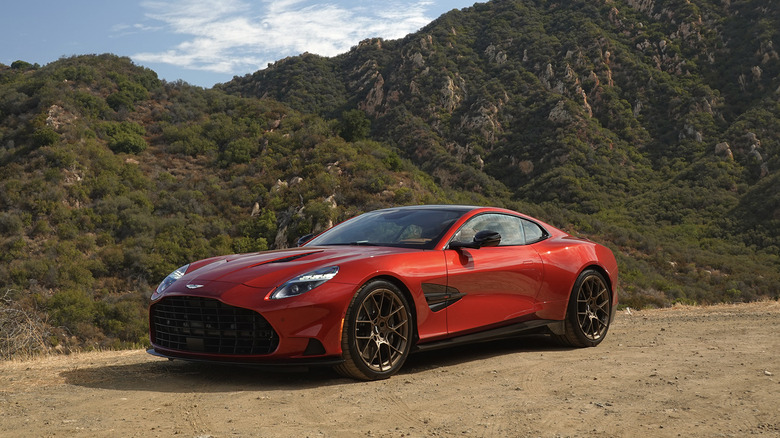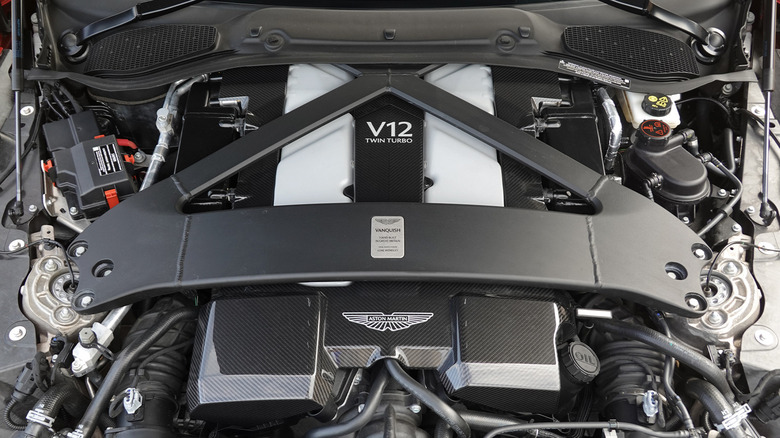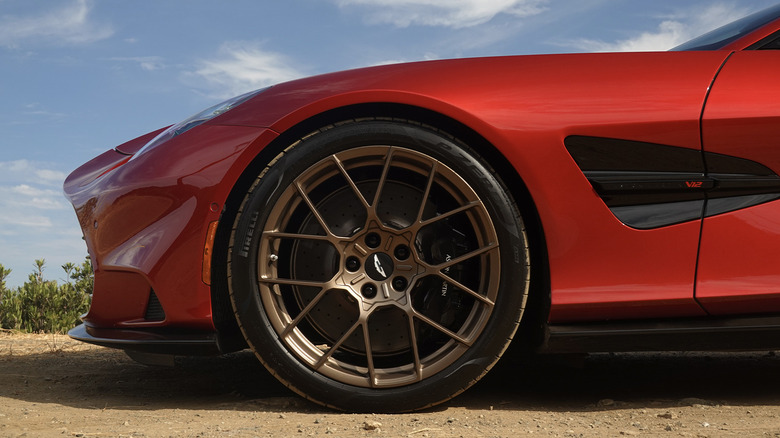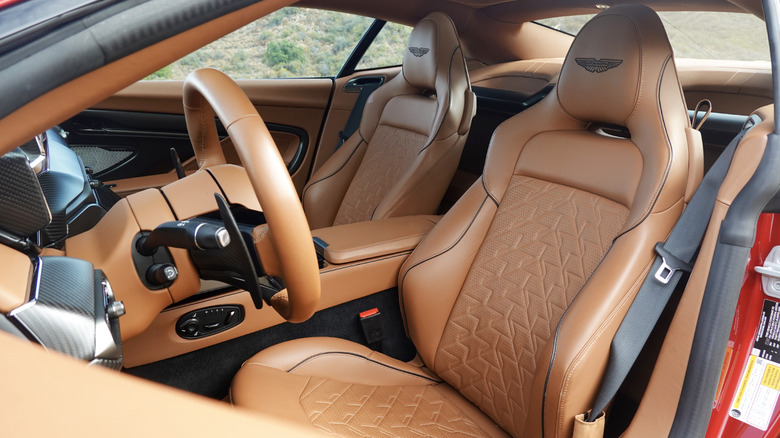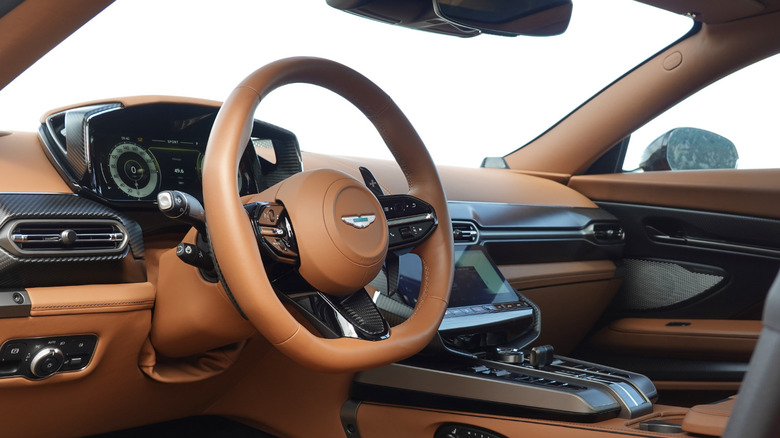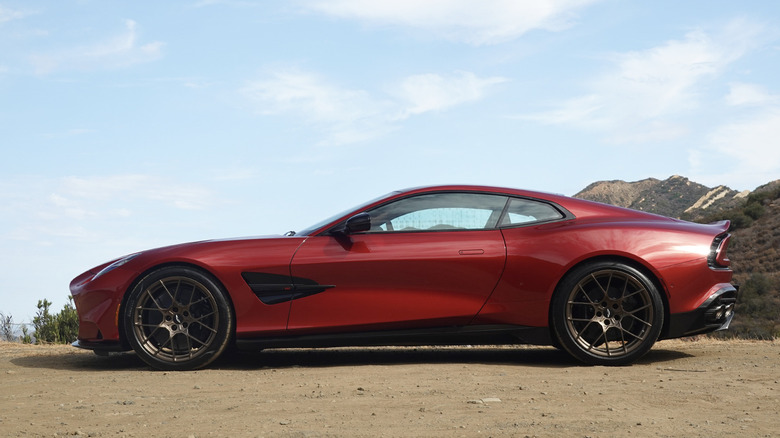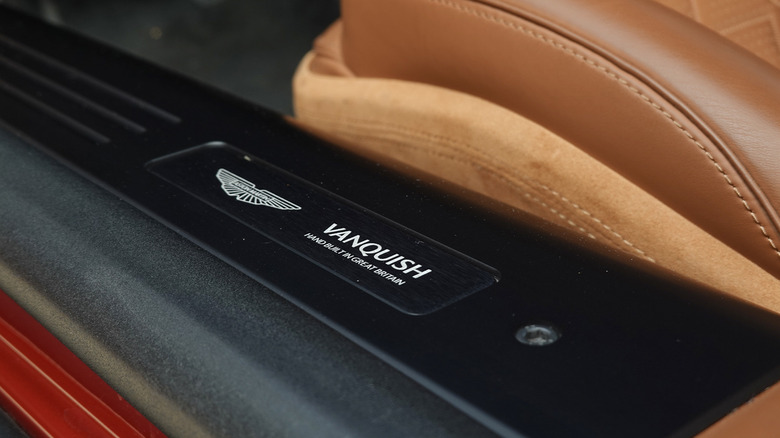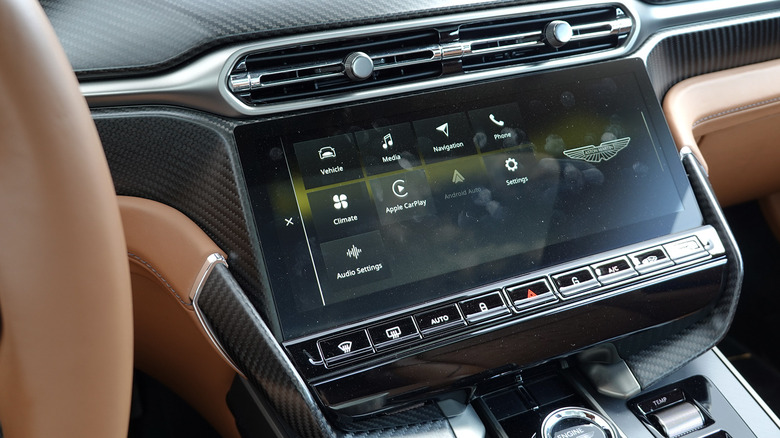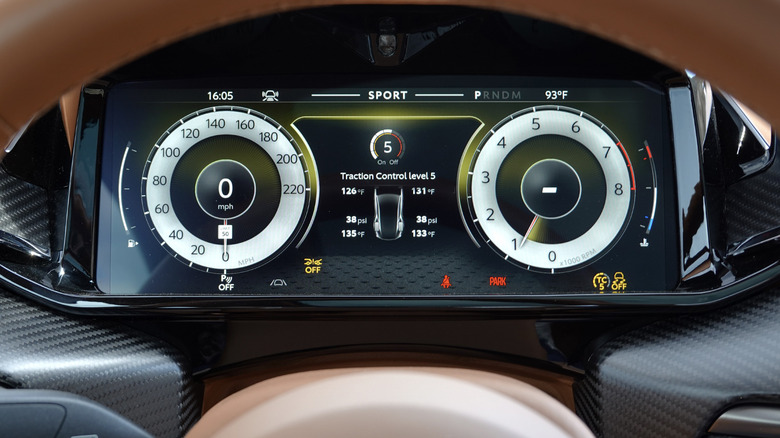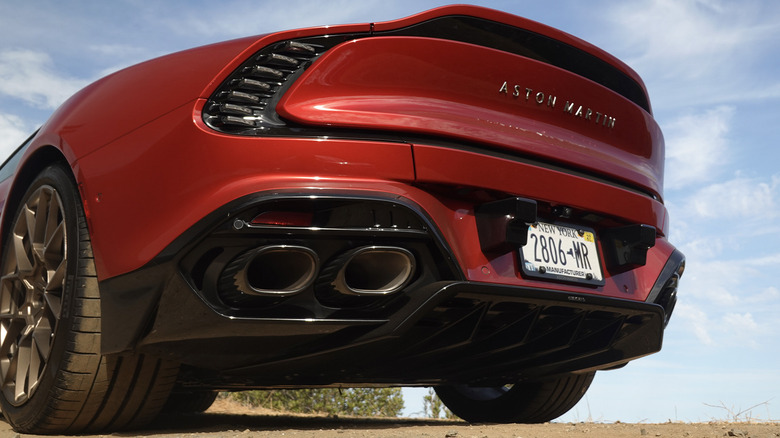Aston Martin's New Vanquish Costs Half A Million Dollars, So I Made It My Daily-Driver
Last year, Aston Martin revived the Vanquish at the top of the lineup. And as with most of the company's decisions under Lawrence Stroll, the new generation messes around not even a tiny little bit. With a twin-turbo V12 as the highlight, serious power, and super-luxe trappings throughout, this stunning continuation of Aston's recent design language introduces lean muscle into a surprisingly large form. Meanwhile, the new interior revamp carries over from previous updates to the Vantage, DB12, and DBX.
When I first drove the new Vanquish last year in perfect conditions, on winding roads through beautiful Sardinian countryside, I spent most of the time tying to comprehend the new Vanquish's mechanical underpinnings—and why Aston under Stroll decided to go all-in developing a rear-wheel-drive supercar-meets-tourer at the end of the internal-combustion era. More recently, I took a longer week loaner at home in Los Angeles to better explore how well the Vanquish handles rougher, familiar roads and, really, whether something so stupendously quick and hilariously luxurious can actually serve as a daily driver.
Unparalled presence
In West LA, the epicenter of global Lamborghini Urus culture, most supercars barely warrant a second glance. And yet, the Vanquish still brought serious presence to my neighborhood, where kids and their parents frequently stopped to stare—or snap frequent selfies, without exaggeration. A luminescent shade of metallic red dubbed Supernova probably helps, which shifts from a deep burgundy to a brilliant vermillion depending on the sunlight. The Vanquish rides wider than wide, boggling perception among the raft of boring crossovers and the occasional Prius on public roads, and longer than long too, especially at the pinnacle of "dash-to-axle" measurement.
Therein slips Aston's all-new twin-turbocharged 5.2-liter V12, still hand-built in Great Britain with a final inspection by Luke Wensley in this case. Great job, Luke, this engine truly is a masterpiece. Though the mill lacks the screaming upper echelon of revs that some other manufacturers prioritize for V12 powerplants, a gobsmacking 824 horsepower and equally as prodigious 738 lb-ft of torque hit wherever, whenever on the way to "just" a 7,000-RPM redline.
V12 power and a rear-mounted transaxle
Yet despite the easily accessible gut punch available anywhere on the tach, the Vanquish also builds into deeper and deeper power reserves with a satisfying swell of spooling turbos. Roll the windows down and some whine enters the svelte cockpit, though the booming titanium exhaust (don't ask how much, okay fine, a $14,900 option) soon overwhelms all other sensory inputs. Burbling down low, boisterous in the midrange, and then thundering up top in a characterful blast from eras gone past, this powertrain simply begs for deeper and deeper explorations into the throttle pedal's travel.
And remember, this is a transaxle car, which means the gearbox mounts at the rear for improved weight distribution. An alloy torque tube houses a carbon-fiber prop shaft routing to an electronically controlled differential all the (way, way) way back there, but throughout my loan, the dual-clutch trans still stood up to my previous claim of being the second best yet, only behind the telepathic and unflappable PDK in Porsche's latest and greatest.
The Vanquish's overall weight, and the rotational inertia of that 5.2-liter V12 might help, but the DCT almost never chugs through gears at lower speeds as lesser dual-clutches so often do—the one exception being under the lightest braking load, when gearshifts from fifth down to fourth, third, and second from maybe 35 to 20 miles per hour do cause occasionally abrupt changes in deceleration that my foot on the brake pedal struggled to modulate.
Exploring the subtle side of life
Just drive harder, the argument might go. But I wanted to experience the more stately side of an Aston as grand tourer, in addition to the hard-charging personality that the roads of Sardinia manifested (against my will, surely). In town, the Vanquish's softest suspension damping rides just firm enough to impart a sense of potential energy, the rigid chassis barely floating over imperfections and rougher portions of asphalt while always retaining a sporty demeanor. Most of the undesirable feedback evaporates, though some tire noise intrudes on the reverie due to the extensive use of aluminum and carbon-fiber components, which tend to increase reverberations through a car's structural elements.
The light, yet precise, steering familiar to the Vantage, DB12, and DBX also carries over. A bit more progressive resistance off center might help to improve overall feel, though I doubt measurable performance might increase. Or a thinner rim to the steering wheel, maybe. Sport mode amps up the response, but I found Sport+ almost went too firm, dulling the communication between road, tire, and hand a bit too much in the name of all-out rigidity and pace.
Too powerful to unleash properly on public roads
Mostly, I appreciated everything about the Vanquish that made daily life comfortable. The seats, perfectly bolstered for dynamic driving and cruising without claustrophobia. The legroom, no 2+2 here. The easy visibility, despite the eternal hood, which makes a car that otherwise might inspire some timidity in traffic almost shockingly easy to negotiate through tight spaces. And then of course, the power, available with every microscopic movement of my right big toe...
Does the Vanquish truly need 824 horsepower? Absolutely not, but rather than exploring the full output at every opportunity, I more often reveled in how the V12 doles out shove at one-third to three-quarters throttle. Highway passing requires only the former, with a quick pop of the lefthand paddle shifter to find a gear or two lower in the stack, then the building turbo rush gloriously capping off a quick maneuver through rush hour. Anywhere past halfway in the go pedal's travel, meanwhile, and the headrest ergonomics all of a sudden came into play.
Impeccable talents in every driving scenario
Push much further, as I simply needed to in the name of science on a few familiar roads, and the Vanquish can hustle with the best sports cars and supercars despite the size and weight. Even a second or two of full gas coming out of a corner quickly brings on speeds far in excess of legality or sanity, but along the way, this Aston is a willing and communicative partner in crime, dancing with impeccable weight transfer and lithe capability made possible by the transaxle layout and wide footprint. A curb weight over 4,000 pounds with me in the driver's seat simply seemed impossibly high.
Time on a racetrack might reveal further limitations based on that weight, including but surely not limited to tire wear. I also wonder about heating and cooling while pushing to the limit, even though the enormous front intake grille—a clear reference back to James Bond's DB5—undoubtedly gulps up plenty of air as speeds increase. A nice V12 and two big turbos won't help, but at least the lack of a transmission bolted directly onto the engine should.
Wishing for front-axle lift
The only issue I discovered in the canyons around Los Angeles revealed some of that heft in surprising places, though. Namely, that the front splitter scraped constantly. Like all the time, on roads I know better than the back of my hand, where Lambos and Ferraris and McLarens don't contact asphalt. Luckily, this loaner's front end lacked a carbon-fiber lower fascia—probably a smart call by Aston, given the Vanquish's obvious proclivities due to the long nose and overall mass. I wound up playing around to avoid any cringey dragging noises, trying to hit the brakes then lift off to prompt a bit of weight transfer toward the tail anytime a dip approached.
Forget about steep driveways. After some initial shock when I discovered the Vanquish lacks front-axle lift, I never even tried to park in my relatively level driveway at all. Suffice to say, a car priced at $530,500 with options on a $442,000 base price should come with the ability to protect itself from potentially costly damage.
A crowd pleaser, for crowds of one
Other than ripping around the canyons and commuting to the grocery store, I spent plenty of time chauffeuring friends to dinner, since everyone wanted to experience the Vanquish all the time. All that saddle tan leather, the carbon-fiber trim, and knurled metal switchgear made strong impressions to match the exterior design and unavoidably enjoyable powertrain. One person pointed out the use of piano black plastic on the center console, which this particular Vanquish deletes most of in favor of brushed metals, though the remaining pieces only then stand out all the worse.
I simply loved slipping into the Vanquish for every drive, and wound up racking up a ton of miles on the odometer—again, in the name of science. For regular life, the trunk barely ekes out enough storage space for a couple of weekend bags, and everything back there gets piping hot almost immediately, likely due to the transaxle and exhaust packaging. Speaking of hot, I also prefer a slicktop to the glass roof, but luckily the air conditioning and ventilated seats worked pretty well at the height of summer.
CarPlay Ultra connection struggles
My main complaint for the Vanquish? How Apple CarPlay Ultra stopped working so often that I simply stopped trying to activate the software, instead choosing to stick with traditional CarPlay which connected much more consistently. This ran counter to the two other Astons I've tested with Ultra previously, both of which only failed when I purposefully tried to confuse the system by turning on airplane mode or switching off my iPhone mid-drive, so I struggle to explain why the Vanquish all of a sudden presented issues.
And lacking Ultra, after one is acclimated to the new capabilities, does kind of suck. No longer needing to dip out of the familiar interface to adjust climate settings or sound equalization makes life much nicer, even if a few little details like the ability to pull up Waze on the gauge cluster might make for solid additions in future updates.
Fuel economy? Not a concern...
Then, a couple of times, the sound system stopped working entirely. No Bluetooth, no radio, no CarPlay alike. Oh well, a power cycle seemed to fix this—though on a particularly long drive out to the desert, I unfortunately suffered through listening to the V12's spectacular soundtrack as a form of mindfulness meditation instead of tunes. After putting on about 400 miles of mixed driving, that V12 drank about two 21.6-gallon tanks of gas—such are the sacrifices necessary to enjoy one of the best engines ever made.
The V12 itself also enjoys pushing hard, but doing so can occasionally upset the traction control's base (read: conservative) settings. Not that the Vanquish won't slide around, stiff chassis and wide tires and all, but moreso that the power cuts due to traction control intervention happen somewhat abruptly, interrupting weight transfer in the name of safety—if not driver predictability. Luckily, Aston's drive mode dial doubles as a discretely controllable traction control knob after switching off ESC.
Traction and stability control make fiddling fun
On dry roads, I found the power delivery starts to smooth out with TC set to 5 out of 8 (plus fully off). This introduces a hint of happy oversteer fun factor without the opportunity for too much sketchy drifting action. Going full off, on the other hand, gets rowdy fast. I fully support this behavior, of course, but for most owners, unleashing 824 horsepower in a rear-wheel-drive car that costs half-a-million bucks might not sound particularly enjoyable.
Once I hit a few bouts of desert monsoon rains, I needed to focus on how to turn ESC and TC back on. Because the drive mode knob now controls the settings, turning the knob no longer switches out of Sport or Sport+. Instead, I glanced down repeatedly to re-find the dedicated traction button by my right quad, then after pushing that button, went back up to the drive mode dial. Oh well, even if this caught me by surprise more than a couple of times, even in a downpour, the Vanquish's throttle modulation, confident weight distribution, and responsive steering never led to any moments of doubt—other than those I purposefully brought on with a wry smile and quick hits of hooligan countersteering.
2025 Aston Martin Vanquish verdict
Aston must feel a sense of relief for the Vanquish. Under Lawrence Stroll's guidance, the legacy British automaker keeps building better and better cars, all of which receive rave reviews from the motoring press and owners alike, and then enter the market priced at surprisingly competitive levels. A sublime Vantage costing less than a Porsche 911 Turbo, for example, boggles the mind. And Aston continues to eschew hybridization and all-wheel drive as routes to uncorking even more power, at least for the foreseeable present.
But how then to explain sales that never quite seem to match expectations despite the exoticism and the relative attainability, as well as the surging popularity of Formula 1 (where a Vantage serves as pace car)? Well, judging from the handful of privately owned Vanquishes I've already spotted around LA, despite the claimed output being limited to just 1,000 per year, the new Aston flagship must be hitting the mark. As I handed back the keys, I wound up wishing the Vanquish might vanish in James Bond style from Aston's paper trail and reappear in my garage for a lifetime of V12 super-GT fun. Well, maybe in gunmetal gray over black if a guy can dream. And unless a Valour miraculously appeared instead, anyhow.
